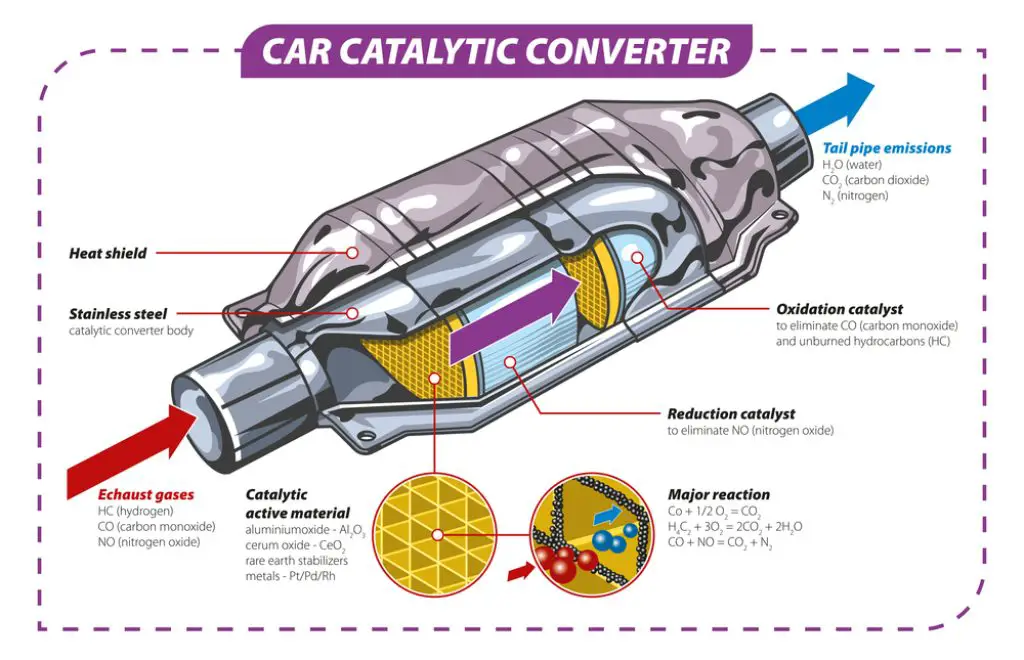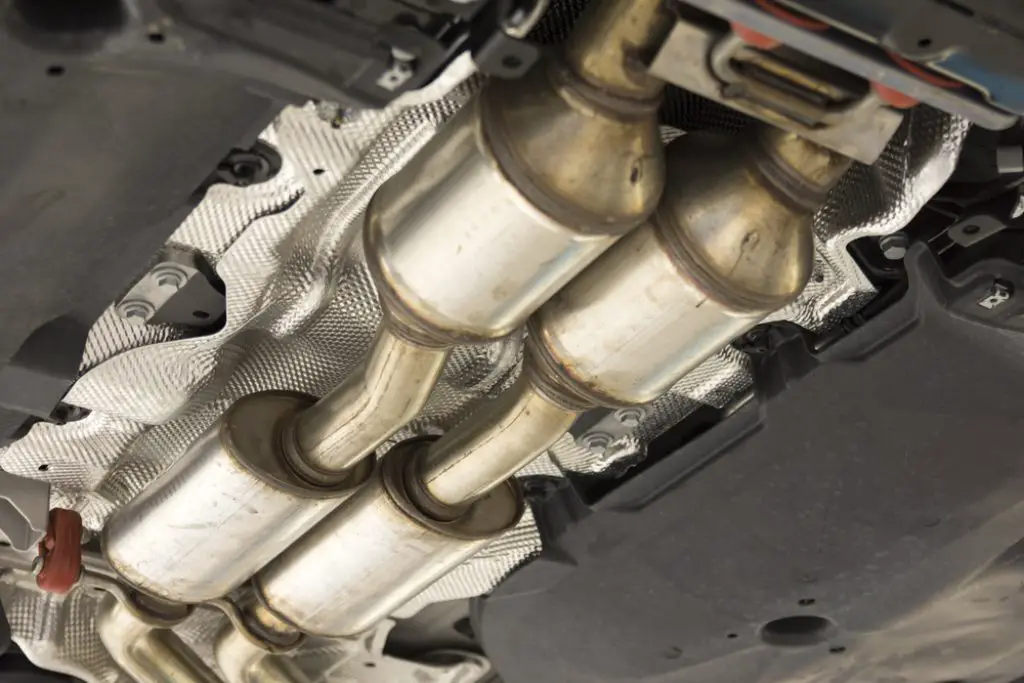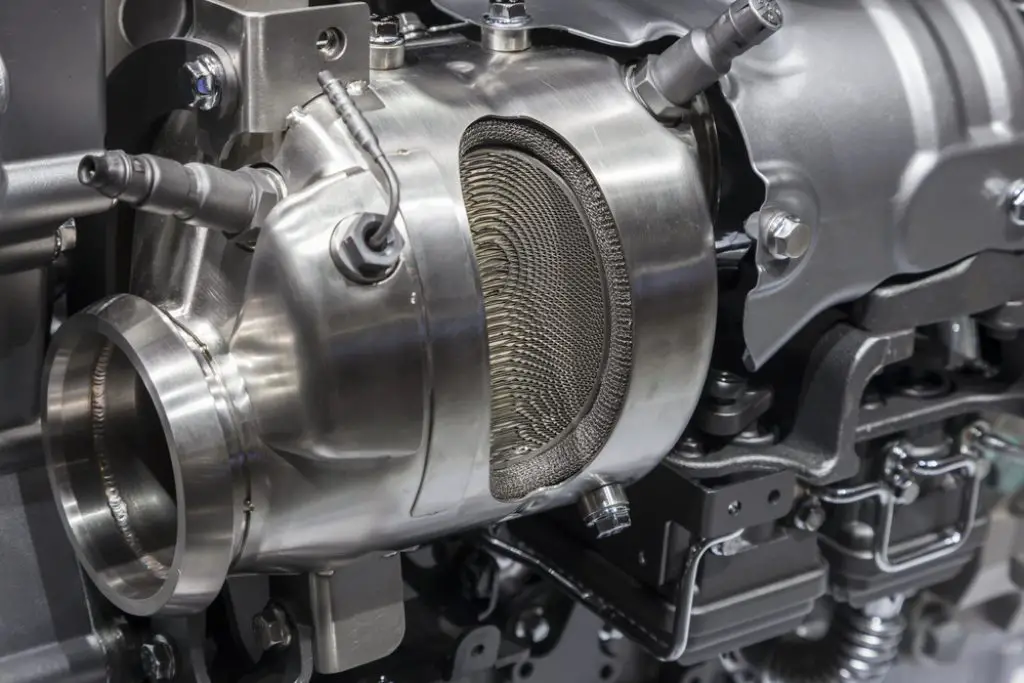We hope you love the products we recommend and just so you know that as an Amazon Associate EngineHoist.net may earn from qualifying purchases.
The catalytic converter is a critical component of your vehicle’s exhaust system, often overlooked in regular maintenance routines. This inconspicuous device plays a vital role in reducing harmful emissions by converting them into less damaging substances.
Understanding the importance of a clean catalytic converter, and how to clean a catalytic converter without removing it, is essential to the longevity of your vehicle and the environment. When a catalytic converter becomes clogged, it can lead to reduced engine performance, increased emissions, and potential damage to other parts of the engine.

Symptoms of a clogged catalytic converter might include:
- a decrease in gas mileage,
- a rough-running engine, or
- a warning light on your dashboard indicating an emission system problem.
To tackle this issue, there are several methods you can try. One of the easiest ways is to use a catalytic converter cleaner, such as Cataclean or Seafoam.
| How to clean catalytic converter Cataclean: | How to clean catalytic converter Seafoam: |
These fuel additives are designed to clean and unclog the converter while you drive. Simply add them to your gas tank and follow the instructions on the product. Additionally, some enthusiasts suggest performing a burn off procedure by driving the car at high speeds for a few miles, trying to get the engine to reach 2500-3000 RPMs. This process helps to heat up the converter, which may assist in burning off accumulated deposits.
Another method involves using a process to clean catalytic converter with vinegar mixed with water as a cleaning solution. You can pressure wash catalytic converter with this mixture, but exercise caution and avoid directly spraying other engine components.

Lastly, there are various catalytic converter cleaner reviews available online that can provide insights into the best products and techniques to use.
Remember, always prioritize safety and follow the instructions provided by the cleaner or any other cleaning method you choose. If you’re unsure or uncomfortable with these procedures, it’s recommended to consult a professional mechanic. Read on to find out more about the different procedures to clean a catalytic converter.

What You Need To Know Before Cleaning a Catalytic Converter Without Removing It
Embarking on the task of cleaning your catalytic converter without removing it from your vehicle might seem daunting, but with the right knowledge and tools, it can be a straightforward process. There are distinct benefits, such as the potential savings on labor costs and the possibility of extending the life of your catalytic converter.
However, it’s crucial to remember the risks, too; improper cleaning might harm your converter or other engine components. Essential tools include a specific socket for the oxygen sensor, safety gloves, and eye protection.
A Close Look at Commercial Catalytic Converter Cleaners
An array of commercial catalytic converter cleaners is available in the automotive market, each promising to be the magic solution for your clogged converter.
These cleaners typically work by using chemicals to break down the carbon deposits inside the converter that cause the blockage. These products are the easiest way to clean catalytic converter. Understanding how these cleaners work can help you choose the most effective product and use it correctly.
Choosing the Right Catalytic Converter Cleaner for Your Vehicle
Not all vehicles are the same, and neither are their catalytic converters. Therefore, choosing the right cleaner for your particular vehicle is essential. Consider factors such as the age of your vehicle, the type of fuel it uses, and the severity of the clog.
Brands like Cataclean, Sledgehammer, and CRC are widely recommended in the automotive industry.
Step by Step Guide: How to Clean a Catalytic Converter Without Removing It
DISCLAIMER: Do It at Your Own Risk!
This guide is just for information and doesn’t replace professional advice. If you’re not confident or experienced in car repairs, it’s best to seek professional help.
Cleaning a catalytic converter without removing it involves risks. You could injure yourself, damage your vehicle, or even void your warranty. We’re not responsible for any trouble you might run into.
Keep safety first! Use proper protective gear and follow the instructions for tools and cleaning products. Also, consult your vehicle’s manual for specific details.
Remember, you’re in charge of your actions. By following this guide, you’re taking responsibility for any outcomes. Stay safe and make informed decisions.
- Preparation: Start by gathering all the necessary tools and equipment you’ll need. This includes your chosen catalytic converter cleaner, a wrench or socket set for removing the oxygen sensor, a pair of gloves for protection, and eye protection.
- Vehicle Safety: Park your vehicle on a flat and stable surface. Ensure the engine is cool before starting this process to avoid burns or other heat-related injuries.
- Remove Oxygen Sensor: Locate the oxygen sensor on your vehicle, which is typically found on or near the catalytic converter. Using the appropriate size wrench or socket, carefully unscrew the sensor. Make sure to keep it in a safe place to prevent any damage.
- Apply the Cleaner: Take your chosen catalytic converter cleaner and spray it directly into the sensor hole. Follow the instructions on the cleaner’s packaging for the exact amount to use.
- Let the Cleaner Work: Once the cleaner is applied, allow it to sit for the recommended amount of time specified by the cleaner manufacturer. This allows the cleaner to break down and dissolve any carbon deposits and other build-up inside the converter.
- Drive the Vehicle: After letting the cleaner sit, start the engine and drive your vehicle for a certain distance or period as per the cleaner’s instructions. This allows the cleaner to work through the converter while the engine is running.
- Reattach the Oxygen Sensor: Once you’ve driven the vehicle for the recommended amount of time, turn off the engine and let it cool down again. After it’s cool, reattach the oxygen sensor using your wrench or socket set.
- Observation: Finally, observe your vehicle’s performance over the next several drives. If you notice an improvement in power, fuel economy, or a reduction in emissions, the cleaning has been successful. If not, you may need to repeat the process or consult with a professional mechanic.
Remember, safety should be your primary concern when working on your vehicle. Always wear protective gear and follow the instructions of any products you use. Additionally, consult your vehicle’s manual or a trusted mechanic if you’re unsure about any steps.
Troubleshooting Common Issues During the Cleaning Process
No process is without its potential hiccups, and cleaning your catalytic converter is no exception. Stubborn deposits might resist initial cleaning attempts.
If this happens, multiple applications of the cleaner might be necessary. If your catalytic converter remains clogged despite your best efforts, it may be time to consider professional help or replacement.
Post-Cleaning: Evaluating the Success of the Process
Once the cleaning process is complete, it’s crucial to evaluate the results.
Signs of a successfully cleaned catalytic converter include improved engine performance and gas mileage, as well as the disappearance of any warning lights on your dashboard.
Remember, though, that performance changes might not be immediate; it could take some time for the cleaner to fully break down and remove the deposits.
Frequently Asked Questions About Cleaning a Catalytic Converter Without Removal
Can all vehicles undergo this cleaning method of how to clean a catalyitic converter without removing it?
While most vehicles can undergo catalytic converter cleaning without removal, there are exceptions. Always check your vehicle’s manual or consult with a professional if you’re unsure. As a general rule, vehicles with a lot of miles on them or those that are extremely old may not respond as well to the cleaning process.
Can I use regular detergent or soap instead of a commercial cleaner to clean a catalytic converter?
Regular detergent or soap is not recommended for cleaning a catalytic converter. Commercial cleaners are specifically formulated to break down the carbon deposits in the converter that cause clogging. Using inappropriate substances could lead to ineffective cleaning or, worse, damage to the converter.
How often should I clean my catalytic converter?
The frequency of cleaning your catalytic converter depends on several factors, such as how often you use your vehicle, the quality of fuel you use, and your vehicle’s overall condition. Generally, it’s a good practice to clean the converter every 15,000 to 20,000 miles, or when you start experiencing signs of a clogged converter.
Is there any risk to my vehicle in cleaning the catalytic converter without removing it?
As with any maintenance or cleaning process, there’s a small risk if the cleaning isn’t done properly. That’s why it’s crucial to follow the instructions on the cleaner’s packaging and take appropriate safety measures. However, when done correctly, this method is generally safe and shouldn’t pose a risk to your vehicle.
Can a badly clogged catalytic converter be cleaned without removal, or should it be replaced?
In cases of severe clogging, cleaning may not be enough to restore the converter’s function. In these situations, it might be necessary to replace the catalytic converter. Signs of a severely clogged converter include persistent engine performance issues even after cleaning, unusual noises from the exhaust system, and a significant decrease in fuel efficiency. It’s always best to consult with a professional if you’re unsure.
How do you unclog a catalytic converter without removing it?
Cleaning a catalytic converter without removing it involves using catalytic converter cleaners or fuel additives specifically designed for this purpose. Follow the instructions provided by the cleaner or additive, which typically involves adding it to your fuel tank and driving the vehicle to allow the cleaner to work through the converter.
What will unclog a catalytic converter?
Catalytic converter cleaners and fuel additives are specifically formulated to break down carbon deposits and other build-ups inside the converter, helping to unclog it. These products contain chemicals that react with the deposits, making them easier to expel through the exhaust system.
How do you check if a catalytic converter is clogged?
There are a few signs that indicate a potentially clogged catalytic converter. These include a decrease in engine performance, reduced gas mileage, a rough-running engine, and a persistent “check engine” light. However, it’s essential to consult a professional mechanic to diagnose the issue accurately.
Can you unclog a catalytic converter without replacing it?
In many cases, a clogged catalytic converter can be unclogged without the need for replacement. Using specialized cleaners or fuel additives, as well as performing cleaning procedures, can help remove the carbon deposits and restore the converter’s functionality. However, severe or persistent clogs may require professional assessment or replacement of the converter.
Wrapping Up: Maintaining a Clean Catalytic Converter for Optimal Vehicle Performance
Understanding how to clean a catalytic converter without removing it is an invaluable skill for any vehicle owner.
By regularly maintaining and cleaning your converter, you can ensure optimal vehicle performance, prevent expensive repairs, and contribute to a cleaner environment.
However, always remember to consult your vehicle’s manual or a professional mechanic if you’re unsure about any aspect of the cleaning process. Safe and happy driving!








